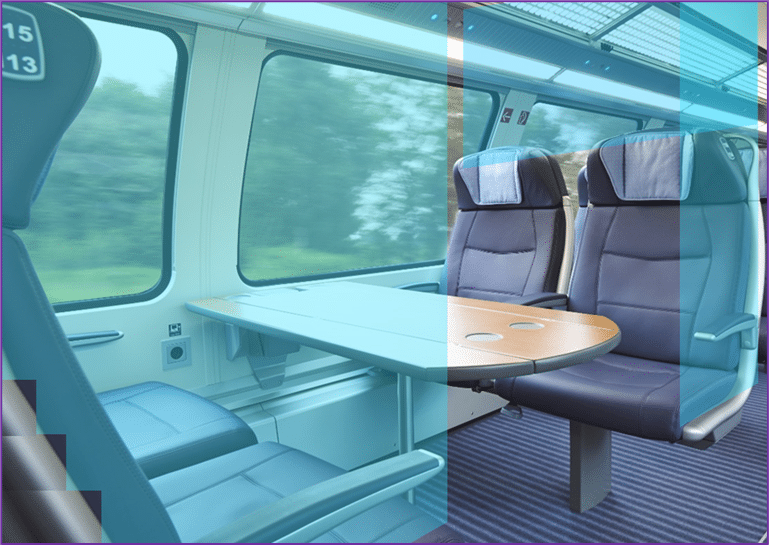As the railways of Great Britain continue to change to entice passengers back to rail after Covid-19, is it time to consider changing interior layouts of the longer distance trains to reinstate the glamour of rail travel? In part one of this two part series, Chris Hoskin, IPEX’s Technical Director explored changing commuter and regional seating. In this second part, he examines changing long distance travel interiors.
The modern InterCity carriage
The passenger saloon as we know it today really dates back to the 1930s where open saloons were used on some services, but the big change was the introduction of the BR Mk2 carriages. BR Mk1 carriages had introduced open saloons but these were broken up by a door and draughtscreens near the midpoint. The Mk2D, 2E, and 2F removed the centre door, included air conditioning, had a fully open saloon, and resulted in the arrangement that perpetuated through the Mk3 and Mk4 carriages, and modern long distance multiple units. In this layout, the carriage can appear more open and airy, although this has been somewhat degraded over the last 20 years by more modern crashworthiness requirements raising the height of the headrest, and in some notable cases, making the windows smaller.
Although undoubtedly easier from a crew perspective, particularly when paper reservations were the norm, it is not necessarily beneficial for the passengers, particularly when a partying group or an individual playing loud music noise-pollutes the entire carriage. Further, as Covid demonstrated, the open saloon is not conducive to social distancing, and in the depths of the pandemic, 90 seated passengers could, for example, “fill” an entire Cl.225, with only 15% of seats occupied.
So what can be done?
One sector of the rail industry that was able to mobilise Covid safe travel particularly effectively was the heritage sector. The vast number of corridor compartment rolling stock, including BR Mk1 carriages meant that overnight the heritage sector could introduce booking by the compartment, which, in addition to being Covid secure, also introduced a very pleasant travelling experience where the only interruption was your, or your family’s, thoughts, and avoided the need to listen to someone else’s choice of music.

Why can’t we just have modern Mk1s?
Anyone who has travelled in a Mk1, or any other compartment stock, will be aware that, although beneficial in a lot of ways, the compartment layout can be restrictive. It can be difficult to scan for a free seat and creates multiple blind spots. This is not good for CCTV coverage, nor is it an optimum layout for PIS visibility. Also, full compartments can create issues for air-conditioning units, with the need for careful design for the ventilation systems.

Can we have compartments again?
With a radical change of thinking – but no less a change than when open saloons became the norm over half a century ago – perhaps there is an opportunity to reintroduce the quiet and comfortable long distance travel experience.
What is envisaged is a side corridor vehicle with all seats in bay layout.
- In standard it is 4+0; in first class, 3+0.
- The seating is similar to that used in the Cl.222 where the seat frame is a single piece so the gap between the seats is solid.
- Between each bay of seats is a glass partition which starts at the top of the seat back and rises to the ceiling. A luggage rack is provided against the side wall of the vehicle as now, but only on the compartment side. To make up for this shortfall, the gap between the bays of seats is also available for luggage.
- A glass side screen is provided from the height of the base of the seat up to ceiling. There is no door to the corridor.
- The ducting for the air conditioning ensures each compartment is adequately ventilated.
- With glass screens the PIS and CCTV visibility is unchanged though some work would need to be completed with lighting to avoid reflection issues.
- It is unlikely that a whole table can be installed as it may make movement of the passenger at the furthest seat from the doorway too restrictive, so investigation into individual tray tables may be necessary, or use of tables with folding sections, as shown in the Deutsche Bahn compartment in Figure 2.
The result is a secure, quiet, comfortable, travel experience, which can also continue in use in a pandemic. If a group is travelling together, they can book their own compartment, whether for social or for business.

Take the Newcastle to Edinburgh route for example. Currently there are services from LNER, Cross Country, Lumo, and TransPennine Express. Each has to vie for passengers. Each offers something different. Each offers its own range of tickets to entice the passenger onto its trains. This provides so much opportunity to provide further choice to the passenger, as Lumo has demonstrated. Could a radical approach to long distance travel such as reintroducing compartments entice people to change their travel habits? Is this the sort of radical change an open access operator would consider to introduce something different?








